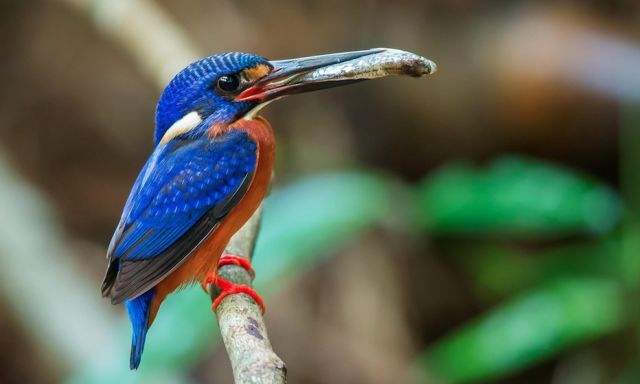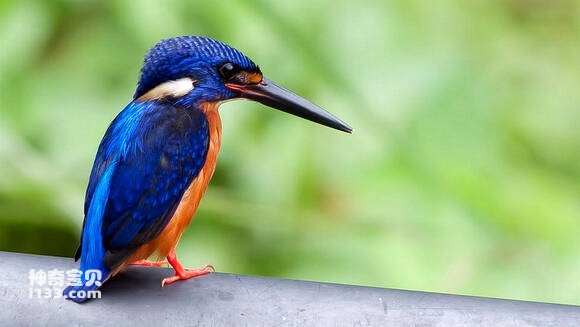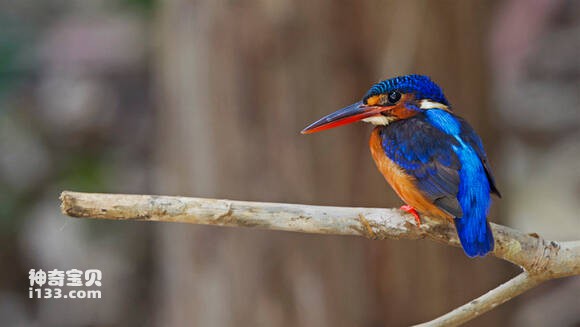Alcedo meninting
IUCN
LCBasic Information
Scientific classification
- name:Alcedo meninting
- Scientific Name:Fish tiger, water dog, fish dog,Alcedo meninting,Blue-eared Kingfisher
- Outline:Climbing birds
- Family:Alcedomorpha Alcedoformes Alcedoidae Alcedo
Vital signs
- length:About 15 cm
- Weight:21-30g
- lifetime:2-5years
Feature
The ear feathers are purple-blue; the throat is light brown; there is a yellow-white spot on each side of the neck
Distribution and Habitat
Blue-eared Kingfisher is distributed in Bangladesh, Brunei Darussalam, Cambodia, China, India, Indonesia, Lao People's Democratic Republic, Malaysia, Myanmar, Nepal, Philippines, Singapore, Sri Lanka, Thailand, Vietnam.
Blue-eared Kingfisher is a resident bird, mainly inhabiting the river banks in evergreen broad-leaved forests below 1,500 meters above sea level, especially in the streams in the forests with dense forests and rich aquatic animals. It lives in streams, lakes, rivers, and fish ponds. It often acts alone. It likes to perch on low branches on the shore.
Appearance
The forehead, top of the head and nape of the male bird are purple-blue, densely covered with black horizontal stripes. The front of the eye is leather yellow, and the ear coverts and the sides of the head are purple-blue. The upper back, waist and tail coverts are bright blue, among which the tail coverts are darker, and the tail feathers are short and round, dark blue or black with blue. The shoulder and wing coverts are dark blue, and the wing coverts also have blue spots. The flight feathers are black. The secondary flight feathers have purple-blue feather edges, and the innermost secondary flight feathers are almost all purple-blue, with brown inner edges. There is an oblong white or leather yellow-white spot on each side of the neck. The chin and throat are white or leather yellow-white, and the rest of the lower body is chestnut or dark reddish brown. The plumage of the female bird is similar to that of the male, but the red range of the base of the beak is larger. The iris is d
Details
Blue-eared Kingfisher is a small bird with 6 subspecies. There is only the Yunnan subspecies in China, which is distributed in Mengla, Yunnan. There are few records of its ecological biology in China. In 1960, the famous scientist Professor Zheng Zuoxin and others caught one by a river in Mengla.

The blue-eared kingfisher is solitary and usually lives alone on branches or rocks near the water, waiting for opportunities to hunt. Its food is mainly small fish, and it also eats crustaceans and a variety of aquatic insects and their larvae. It also eats small frogs and a small amount of aquatic plants. It flies and dives to the water surface to catch fish and shrimp with its sharp beak. They move alone or in pairs, standing on branches or rocks near the water for a long time and observing patiently. When they find small fish floating to the surface, they dive to the surface and catch the fish with their sharp beaks, then fly to trees or rocks to eat them. They dig tunnel-like caves in sandbanks or mud cliffs, lay eggs in them, and feed their young birds. Because of their unique hunting method, they are commonly known as "fishermen". They like to live and forage in ponds, swamps, and streams, and often rest quietly on the leaves in the water or on the branches of trees on rocks by the water. They stare at the water surface with their eyes fixed. Once they find food, they fly straight at lightning speed to catch it, and then return to their habitat to wait. Sometimes they fly on the water surface like a rocket, which is very beautiful. Because this bird loves to eat fish, people also call it "fish tiger", "water dog" and "fish dog". Call: a long-drawn scream, tea-cher.

The breeding season of the Blue-eared Kingfisher is from April to August. It nests on the cliffs on the banks of the river in the forest. It digs its own holes to build its nest. The blue-eared kingfisher can use its thick beak to dig holes in the earth cliffs to build nests. It also builds nests in tunnels on field embankments. The nest chamber is spherical. Like woodpeckers, these cave birds generally do not have bedding at the bottom of the cave. The eggs are laid directly on the ground of the nest. Each nest has 6-8 eggs. The eggs are pure white, bright, slightly spotted, and are about 28 mm × 18 mm in size. There are 1-2 nests per year; the incubation period is about 21 days. The male and female incubate the eggs together, but only the female feeds the chicks.

Listed in the "Red List of Threatened Species of the World Conservation Union" (IUCN) 2016 ver 3.1-Least Concern (LC).
Listed in the second level of China's "National Key Protected Wildlife List" (February 5, 2021).
Protect wild animals and stop eating game.
Maintaining ecological balance is everyone's responsibility!








